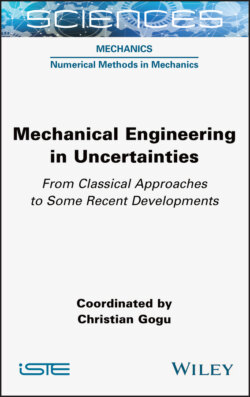Читать книгу Mechanical Engineering in Uncertainties From Classical Approaches to Some Recent Developments - Группа авторов - Страница 18
1.3.2. Probabilistic approach for modeling aleatory uncertainties
ОглавлениеUncertainty of an aleatory nature can typically be modeled by a random variable with a certain probability distribution. In an engineering context, the probability distributions of the random variable quantities of interest can rarely be described in a fully analytical manner. In this case, these distributions are instead constructed from samples of the quantities of interest, which can be obtained either experimentally or by simulation. These samples can then be used to construct an empirical estimate of the distribution function of each random variable.
DEFINITION 1.12.– Let (x1, …, xn) denote n samples of a random variable of distribution function FX. The empirical cumulative distribution function (ECDF) is then defined by:
[1.8]
where 1A is the indicator function of event A. It can be shown that the ECDF is an unbiased estimator of the CDF. An illustration of the ECDF obtained from 100 samples from a reduced centered normal distribution is provided in Figure 1.2. The CDF of this normal distribution is also shown.
Figure 1.2. Example of an empirical cumulative distribution function (ECDF, in blue) obtained from 100 samples of a reduced centered normal distribution. The true cumulative distribution function (CDF) is given in dotted magenta. For a color version of this figure, see www.iste.co.uk/gogu/uncertainties.zip
From these same samples, empirical quantities such as the empirical mean or variance can also be calculated.
DEFINITION 1.13.– Let (x1, …, xn) denote n samples of a random variable. The empirical mean of the samples is defined by
[1.9]
DEFINITION 1.14.– Let (x1, …, xn) denote n samples of a random variable. The unbiased empirical variance of the samples is defined by
[1.10]
Hypothesis tests, such as the Kolmogorov–Smirnov test, make it possible, in addition, to verify whether a sample is derived from a certain distribution function. It should be noted that, when these tests do not allow us to determine with a sufficient level of confidence that the sampling follows a certain probability distribution, it is still possible to construct a continuous approximation of the distribution function using kernel estimation techniques (also known as Parzen– Rosenblatt methods) (Silverman 2018, see also section 7.5.1 of this book).
All of these techniques of empirical statistics work quite well when the number of samples is large enough. This is typically the case in the field of mechanics, when tests are carried out on elementary specimens in order to characterize the variability of a property (for example, failure stress and fracture toughness). In this case, up to 100 samples may be available, which is usually sufficient to characterize the variability in question.
There are, however, many cases where the number of samples available is not sufficient to properly characterize the probability distribution related to an aleatory uncertainty. In this case, this means that, in addition to the aleatory uncertainty, there is also an epistemic uncertainty related to the poor knowledge of the probability distribution of the random variable from which the samples are derived. Several options are then available, depending on the situation:
– if it is easy to obtain more samples, the best way to reduce this epistemic uncertainty is to increase the number of samples. This is typically the case for elementary tests on specimens where the number of tests is increased progressively until a satisfactory estimate of the probability distribution is obtained;
– if more samples cannot easily be obtained experimentally, it may be worth considering whether it would be easier to obtain them by simulation. This is typically the case when moving up the test pyramid of a complex system (for example, an aircraft). While it is relatively easy to perform hundreds of tests on elementary specimens at the base of the pyramid, it is not feasible to perform failure tests on a hundred complete aircraft, that is, at the top of the pyramid. Typically, only one fracture test is performed on a complete aircraft, which is obviously totally insufficient to determine any probability distribution thereupon. On the other hand, numerical simulation can then be considered in order to obtain samples in a numerical way. This typically amounts to propagating characterized uncertainties at a lower level of the test pyramid through a numerical model representing the complete system. For this, consider the function g modeling the response of the system y = g(x1, …, xk) (namely, the quantity of interest on the complete system) as a function of a number of input variables (namely, the parameters whose uncertainties have been characterized at a lower level). Associating random variables X1, …, Xk with the parameters x1, …, xk, the problem of uncertainty propagation amounts to calculating the probability distribution of the random variable Y associated with the response y. When the function g is complex, such as in the case of numerical models (for example, finite elements models) for complex systems, it is not usually possible to characterize the probability distribution of Y in an analytical way. Several methods exist to propagate the uncertainty by sampling, the best-known of which is the Monte Carlo simulation (MCS). It consists of performing N random draws on each of the random variables X1, …, Xk and calculating the value of the response y for each draw. N samples of Y are thus obtained, which makes it possible to characterize the probability distribution of Y using the methods seen previously. For this approach to be interesting, the cost of obtaining N samples of Y by simulation must obviously be much lower than the cost of obtaining the same number of samples experimentally;
– if it is not easy to obtain more samples, neither numerically nor experimentally, this implies that a large epistemic uncertainty will have to be accepted. The question then arises as to the most appropriate approach to model these epistemic uncertainties.
